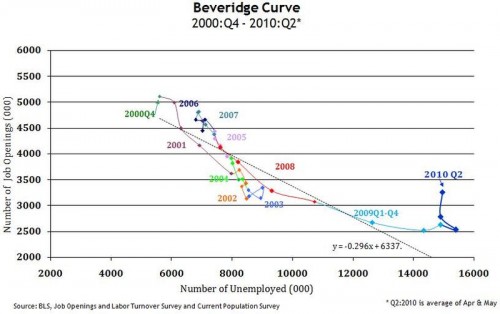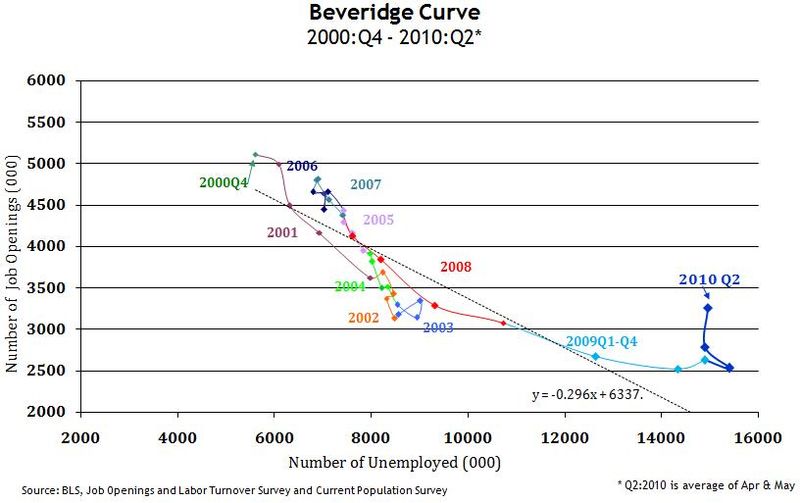I found this article a little while back and it has been gnawing at me ever since. The article discusses the Beveridge curve. The Beveridge curve is the relationship between job vacancies and the unemployment rate.
According to the Beveridge Curve and the second quarter’s JOLT’s Survey (Job Openings and Labor Turnover) the overall trend in new job openings has been positive, yet unemployment has remained unchanged. Another way of putting this is, more employers are hiring as there are more job openings, yet unemployment is not declining. Why?
It seems recessions hit some industries harder. For example, the construction industry is still losing jobs while healthcare is in growth mode. In other words, recessions are industry specific, some industries get hammered, where others can prosper. What the Beveridge curve hints at is people can’t make the transition from one industry to another. It suggests people are waiting for their industry to return rather than switching to a new, growing industry. This lack of transition is creating a very ineffecitent market. Those looking for employees can’t find people with the skills and those looking for work aren’t trying to get the skills. Put differently, the market is looking for and needs employees that don’t exist. It’s not that there are no jobs, there just aren’t the jobs the unemployed can do. This trend coming out of recession has been growing since the 70’s.
. . . in the 1974–75 recession and the recessions of the early 1980s the share of employment in industries continuing recession employment trends was around 50 percent. That share increased to 57 percent for the 1990–91 recession and rose sharply to 79 percent for the 2001 recession. The researchers took these findings as evidence of structural change playing a more significant role in influencing the labor market recovery from the 2001 recession than earlier recessions saw.
It is looking like the number of industries who are continuing recession employment trends for this recession is 65%. That’s 65% of all industries are still loosing jobs, while 35% are adding or are remaining level. Even more interesting, despite the large number of industries not hiring, more employers are adding jobs than people loosing jobs, as this chart suggests.

Notice the uptick in openings with little to no change in the unemployment rate.
People don’t like change. We cling to what we know and look for change in small increments. Unfortunately, there are times where change is our only course of action and inaction can be devastating. I think we are there now.
We need to be progressive as a society and as individuals. Looking to Obama and the government to fix things won’t solve the problem. There is a lot of anger out there, yet we still control much of our own destiny.
Many of the jobs in the industries that are declining aren’t coming back. We need to make the switch. We need to retrain, we need to accept that our economy is changing and the jobs that once fueled it are being replaced by new jobs, not better jobs or worse jobs, just different jobs.
There are opportunities out there. According to the Beverage Curve there are a lot of opportunities out there, more and more everyday. We can hold on to what we know, blame the government, the republicans, the democrats, or the economy, or whatever cause we think desevers the blame or we can look for the opportunities and capitalize on them.
Holding on to the past, keeping things the way they were, rejecting change, or feeling entiteled are all options, but they aren’t solutions.
In difficult and challenging times there are always opportunities. The Beveridge curve just pointed out one. The question is, what are we going to do about it.


